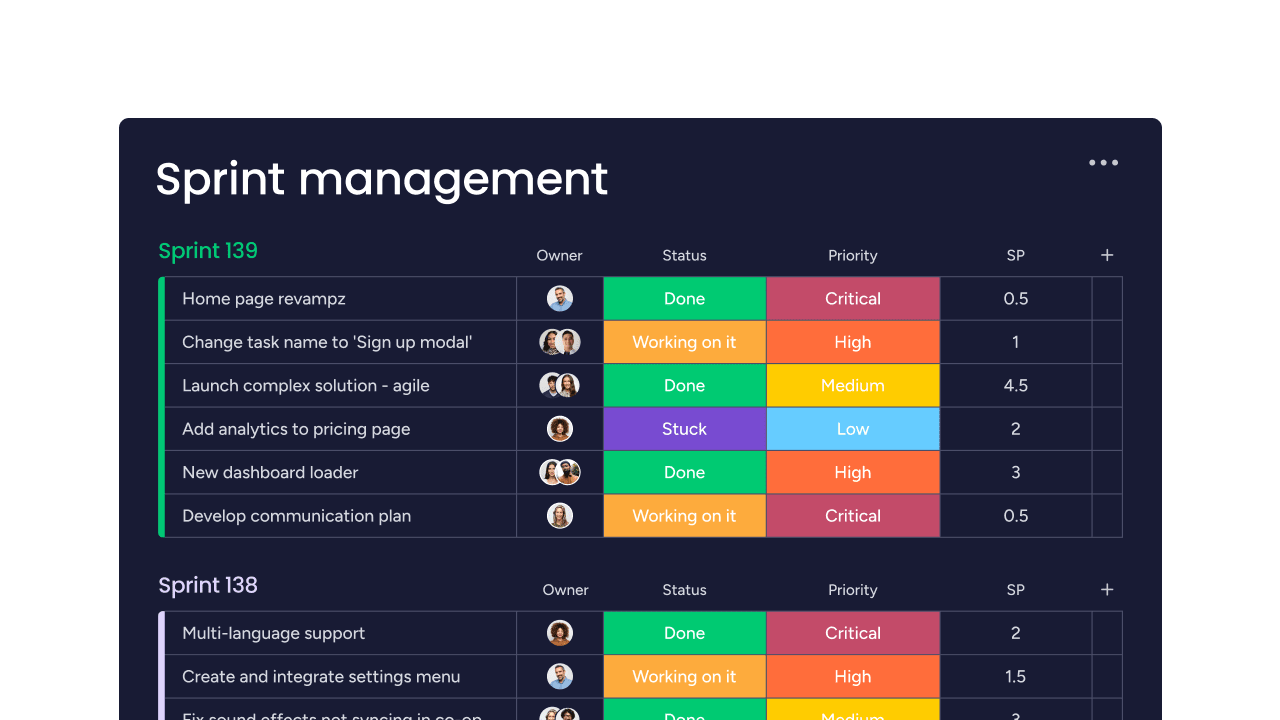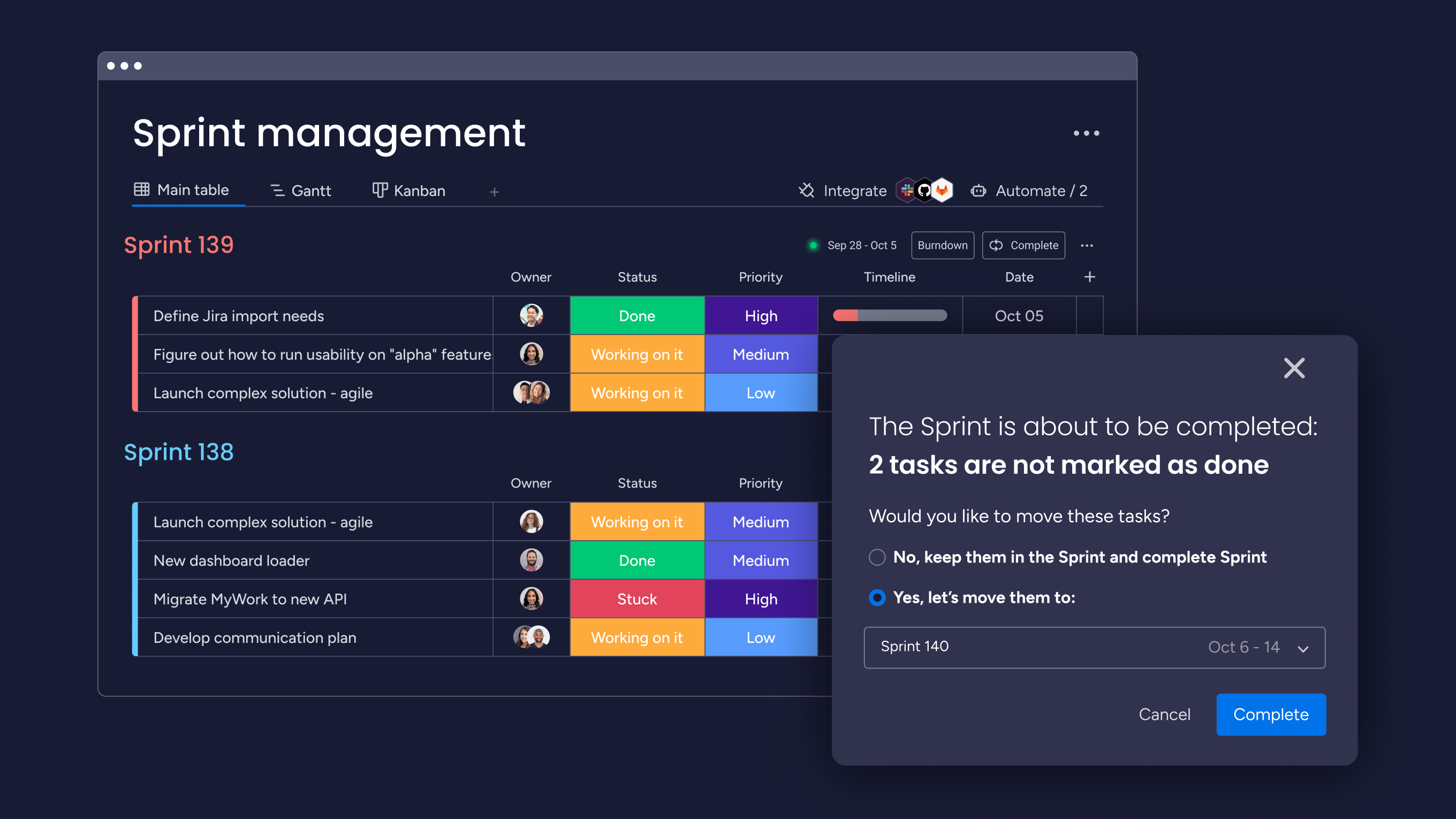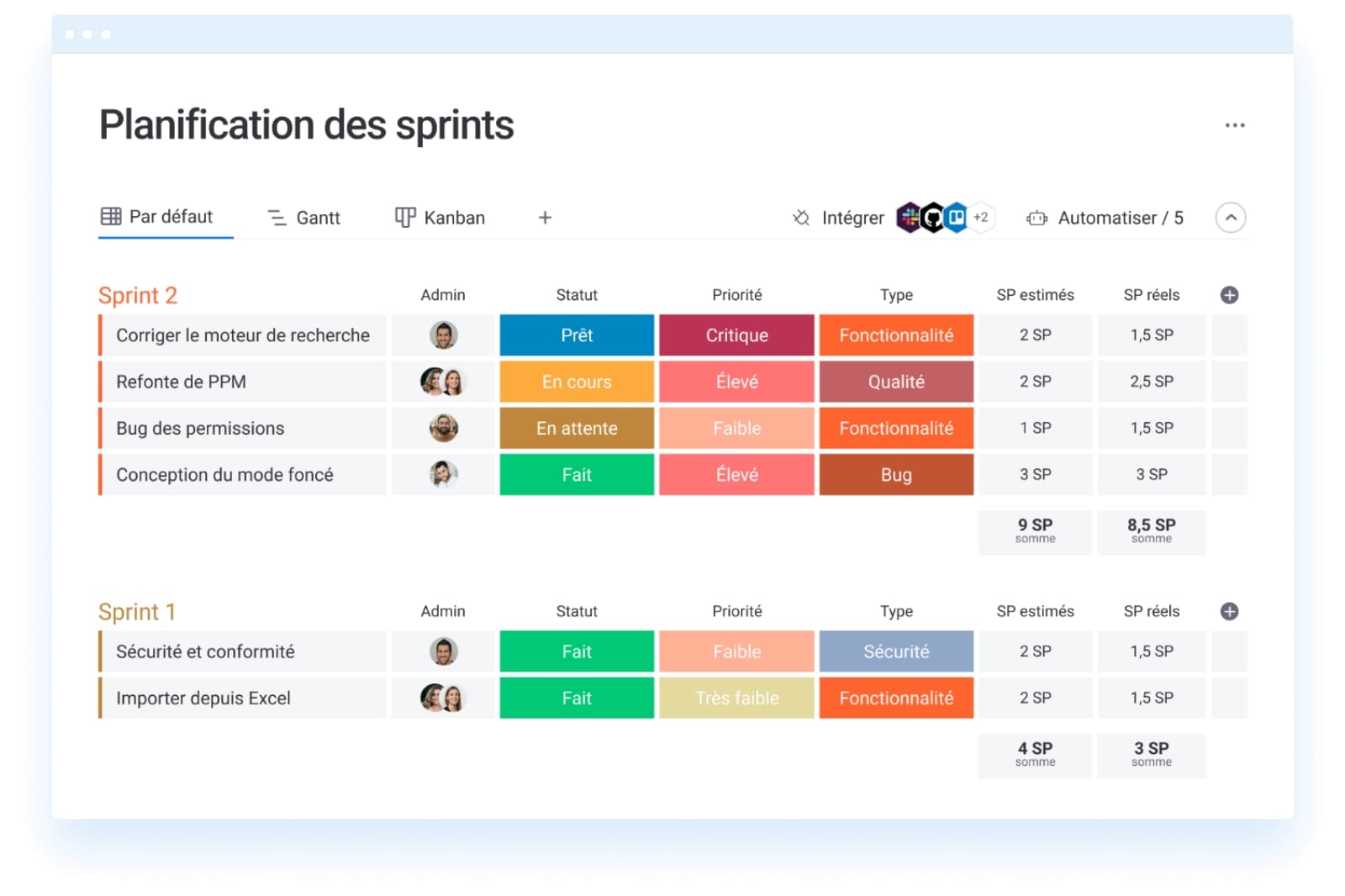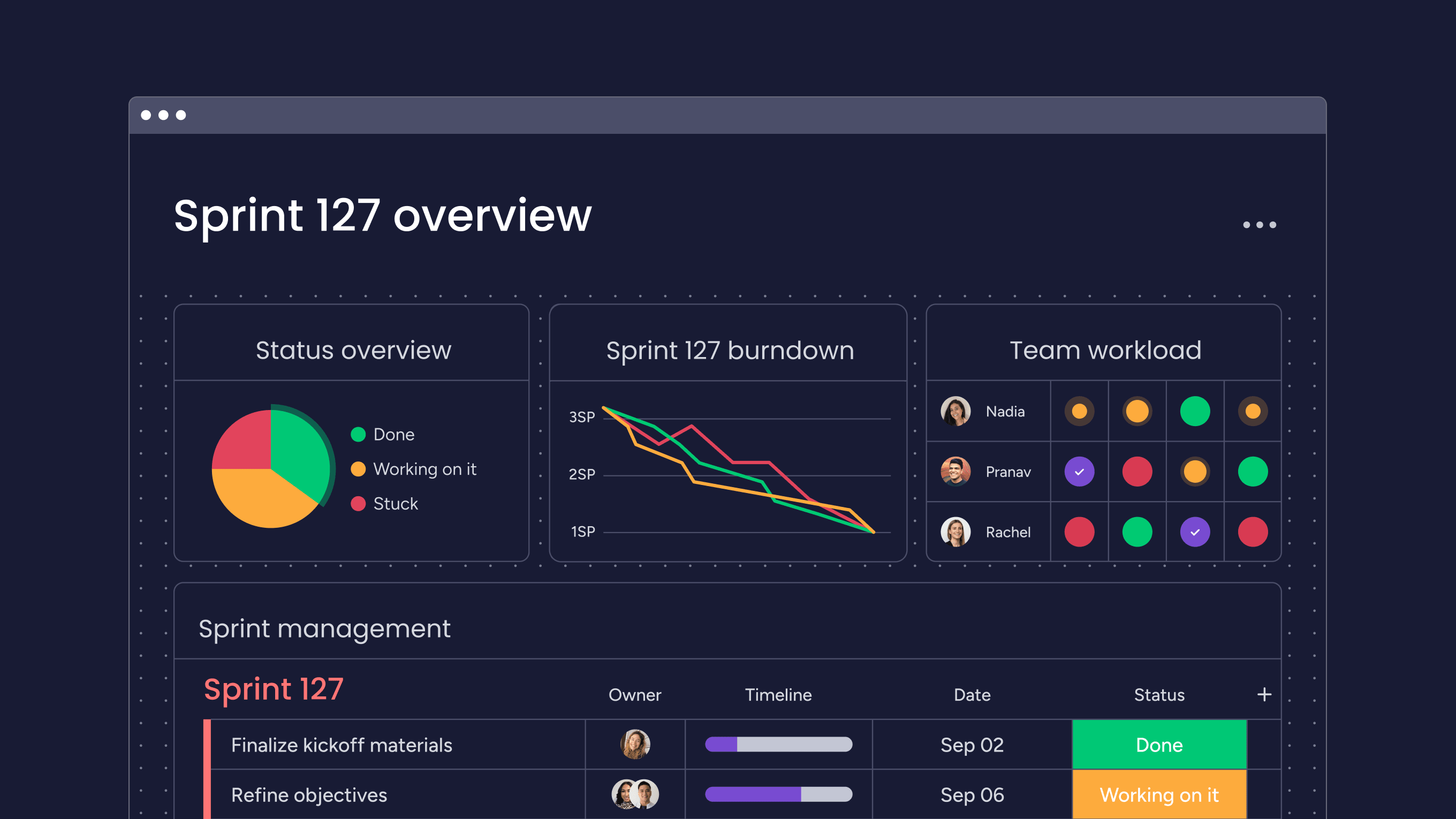Development teams are under constant pressure to deliver faster. But speed without alignment quickly turns into chaos. When daily work drifts away from sprint goals, momentum stalls, rework increases, and stakeholders lose confidence.
Agile ceremonies bring structure to this challenge. They create a steady rhythm of touchpoints that keep everyone aligned, focused, and moving toward the same outcomes.
This guide examines the four core Agile ceremonies that drive successful development cycles. It explains the purpose of each meeting — from sprint planning to reviews and retrospectives — and outlines how to run them effectively, adapt them for distributed teams, and avoid common pitfalls that reduce their value.
More than calendar entries, these ceremonies form a connected system for turning ideas into working software. Supported by flexible workflows and clear visibility, they enable teams to remove blockers, collaborate across departments, and deliver products with confidence.
Key takeaways
- The four core Agile ceremonies keep teams aligned and productive when used together. Sprint planning, daily stand-ups, sprint reviews, and retrospectives each serve a distinct purpose and work best within recommended time limits.
- Remote teams require added structure and facilitation to make ceremonies effective. Video calls, shared screens, and fair rotation of meeting times across time zones help maintain engagement.
- Common pitfalls arise when ceremonies lack focus — meetings that overrun, drift into status updates, or fail to produce outcomes. Preparation and follow-through are essential to keep them valuable.
- monday dev enhances ceremonies with flexible workflows and real-time collaboration. Planning decisions connect directly to execution, while custom boards and AI-powered insights make preparation easier and outcomes more actionable.
- Ceremonies work best as a connected system, not isolated events. Insights from retrospectives should inform planning, while feedback from reviews guides future priorities.
What are Agile ceremonies?
Agile ceremonies are structured meetings that help development teams work together effectively. These time-boxed events happen at regular intervals throughout your agile workflow, creating predictable moments for planning, coordination, and improvement.
The four main ceremonies — sprint planning, daily stand-up, sprint review, and sprint retrospective — each serve specific purposes. Unlike traditional meetings that often waste time, agile ceremonies have clear goals and outcomes that directly support your team’s productivity. This is a critical distinction in a business world where executives now spend nearly 23 hours a week in meetings, a significant increase from less than 10 hours in the 1960s.
The purpose behind Agile meetings
Why do teams need these structured meetings? Agile ceremonies solve real problems that development teams face every day. They prevent miscommunication, keep priorities aligned, and help teams adapt quickly when requirements change.
Agile ceremonies also solve very real problems that development teams face every day by preventing miscommunication and keeping priorities aligned. Each type of meeting is designed to address a specific need within the sprint cycle, from initial planning to final reflection.
- Planning needs: Teams need dedicated time to select and understand their work.
- Coordination needs: Daily check-ins prevent blockers from derailing progress.
- Feedback needs: Regular sprint demos ensure you’re building the right thing.
- Improvement needs: Reflection time helps teams work more effectively over time.
Agile ceremonies vs Scrum ceremonies
The terms are often used interchangeably, but there is a subtle distinction. To understand Agile vs. Scrum, it helps to look at how each framework defines team roles and project scope.
Scrum ceremonies refer specifically to the five events in the Scrum framework: sprint planning, daily scrum, sprint review, Scrum sprint retrospective, and backlog refinement.
Agile ceremonies is a broader term that encompasses similar practices across different methodologies, including Kanban and SAFe vs Scrum approaches. In practice, most teams adopt some version of these core ceremonies, regardless of the framework they follow.

The four core Agile ceremonies for development teams
Agile ceremonies provide the rhythm that keeps development teams moving in sync. Each one has a distinct purpose, but together they form a system that drives continuous improvement. Retrospectives feed into better planning, daily stand-ups highlight blockers for sprint reviews, and stakeholder feedback helps shape future priorities.
The table and list below outlines the role of each ceremony and how to put them into practice.
| Ceromony | Purpose | Duration | Who Attends |
|---|---|---|---|
| Sprint Planning | Select and plan upcoming work | 2-4 hours | Product Owner, Dev Team, Scrum Master |
| Daily Stand-Up | Coordinate daily progress | 15 minutes | Dev Team, Scrum Master |
| Sprint Review | Demo completed work | 1-2 hours | Dev Team, Product Owner, Stakeholders |
| Sprint Retrospective | Improve team processes | 1-2 hours | Dev Team, Scrum Master |
1. Sprint planning
Sprint planning is where your team decides what to build next. You’ll review the product backlog, use agile estimation techniques, and commit to specific work items for the upcoming sprint.
2. Daily stand-up
The daily stand-up keeps everyone synchronized. Team members share progress, plans, and blockers in a quick 15-minute meeting that prevents small issues from becoming big problems.
3. Sprint review
Sprint reviews let you demonstrate completed work to stakeholders. These sessions validate that your development efforts match business needs and user expectations, a crucial aspect of agile product management.
4. Sprint retrospective
Sprint retrospectives, similar to an agile retrospective, focuses on continuous improvement. Your team reflects on what worked, what didn’t, and commits to specific changes for the next sprint.

Sprint planning explained: setting your team up for success
Sprint planning turns the product backlog into an actionable roadmap for the upcoming sprint. This ceremony gives the team clarity on what will be delivered and how the work will get done. Typically, it unfolds in two parts: first, selecting the highest-priority items the team can realistically commit to, and second, breaking those items down into specific tasks.
The goal of sprint planning is balance. A strong plan pushes the team to achieve ambitious outcomes while staying grounded in what can be accomplished within the sprint. Done well, it prevents confusion, reduces rework, and keeps everyone aligned from the very start.
Who should attend sprint planning meetings?
The effectiveness of sprint planning depends on having the right people in the room. Understanding the different agile roles ensures that every perspective is represented:
- Product owner: brings business context and explains the value of each backlog item.
- Development team: contributes technical expertise and provides realistic estimates of effort.
- Scrum master: facilitates the discussion, keeps the meeting on track, and ensures everyone is heard.
- Stakeholders: may join briefly to share context, but should not dominate the conversation or pressure the team.
Together, these agile roles create the balance of business insight, technical knowledge, and facilitation needed for effective sprint planning.
Essential elements of effective sprint planning
Successful sprint planning starts before the meeting. You need a well-groomed backlog with clear user stories and acceptance criteria. Without this preparation, you’ll waste time clarifying requirements instead of focusing on agile planning.
A clear sprint goal guides your team when priorities compete. Platforms like monday dev bring structure to your agile project management approach by preparing for sprint planning with customizable boards that visualize backlogs and track capacity, ensuring productive planning sessions.
Key elements for effective planning include:
- Prepared backlog: Stories refined and estimated before the meeting.
- Team capacity: Understanding of available hours and commitments.
- Definition of done: Shared criteria for completed work.
- Historical data: Past velocity to inform realistic planning.
Optimal sprint planning duration and timing
Sprint planning should be long enough to set the team up for success, but not so long that it drags down momentum. A common rule of thumb is to dedicate about one hour for every week of the sprint — meaning a two-week sprint typically requires around two hours of planning.
The exact time depends on context. New teams or complex projects may need extra discussion, while experienced teams working in familiar domains often plan more quickly. Regardless of the duration, the time invested pays off by reducing confusion and minimizing rework once the sprint is underway.
Try monday devDaily stand-up: 15 minutes to team alignment
Daily stand-ups are one of the essential Scrum meetings that create a consistent rhythm for coordination and problem-solving. The 15-minute timebox forces focus — you’re coordinating work, not solving problems.
What makes stand-ups valuable? They build transparency and encourage mutual support. When someone mentions a blocker, teammates often volunteer help immediately.
Key questions every team member should answer
The traditional stand-up structure uses three simple questions. Each person shares what they completed, what they’ll work on today, and any obstacles they may face. This simple format keeps updates relevant to team coordination.
These questions can also help reveal dependencies and potential conflicts. When someone starts work that depends on another person’s task, you can coordinate timing immediately.
The three core questions are:
- What did I complete yesterday? Focus on progress toward sprint goals.
- What will I work on today? Share specific commitments and priorities.
- What obstacles are blocking me? Highlight issues needing team support.
Running effective remote stand-ups
Remote teams face unique challenges in maintaining stand-up energy. Video calls preserve non-verbal communication, while shared screens display sprint boards for visual reference.
For teams across time zones, consider asynchronous updates. Some teams combine written updates with periodic video stand-ups to balance convenience with connection. monday dev helps support both formats with real-time collaboration features that keep distributed teams aligned.
Avoiding common stand-up mistakes
Stand-ups fail when they become status reports for managers. Keep the focus on team coordination, not upward reporting. When updates turn into technical deep-dives, redirect detailed discussions to separate conversations.
Problem-solving during stand-ups wastes everyone’s time. Identify issues and coordinate follow-ups, but save solutions for smaller groups.
Sprint review: demonstrating value to stakeholders
Sprint reviews showcase your team’s work and gather crucial feedback. These collaborative sessions go beyond simple demos — they connect development work to business outcomes.
Effective reviews strengthen stakeholder engagement: when people see tangible progress and provide input, they become more invested in your product’s success.
Preparing compelling sprint review demos
Great demos tell stories about user value. Instead of listing features, show how your work solves real problems. This approach helps stakeholders understand the business impact.
Focus demonstrations on user-facing functionality. While technical improvements matter, stakeholders provide more valuable feedback when they can interact with features that affect end users.
Preparation strategies for engaging demos include:
- User scenarios: Show features in realistic contexts.
- Working software: Demo actual functionality, not mockups.
- Clear narrative: Connect features to business goals.
- Backup plans: Prepare screenshots for technical difficulties.
Engaging stakeholders and gathering feedback
Never overlook the fact that interactive demos generate valuable feedback. Encourage hands-on exploration and ask specific questions about demonstrated features. Different stakeholders need different approaches too — executives care about business impact while users focus on usability.
Create conversations that inform future priorities. Come prepared with questions and capture feedback in actionable formats.
Converting feedback into actionable items
Sprint reviews only deliver value when feedback turns into action. To make that happen, it’s important to capture input during the session and then collaborate with the product owner to decide which items should be prioritized for the backlog.
With feedback tracking in monday dev, teams can seamlessly turn stakeholder input into structured, prioritized work that flows directly into development. This process works best when teams:
- Assign someone to capture feedback during the review so nothing is lost
- Work with the product owner to evaluate and prioritize new items
- Feed approved items directly into workflows so they move smoothly into development

Sprint retrospective: turning lessons into improvements
Retrospectives drive continuous improvement. Research confirms this ceremony is an opportunity for the agile team to check and correct mistakes, enabling improvements for the next sprint cycle. Teams that invest in retrospectives also see compounding benefits over time and further advance their agile transformation (by building a culture of continuous improvement).
Focus on how you work together, not just what you delivered. Create psychological safety so team members feel comfortable sharing honest feedback.
Five proven retrospective formats
Different formats help teams explore various aspects of their work. Rotating formats keeps retrospectives fresh and examines your process from multiple angles.
Choose formats that match your team’s current needs, including:
- Start, Stop, Continue: Identify new practices, eliminate ineffective ones, maintain what works.
- What went well, What didn’t, What to try: Focus on specific experiences and experiments.
- Timeline: Review significant sprint events and their impact.
- Sailboat: Visualize what drives progress versus creates drag
- The 4Ls: Explore what you Liked, Learned, Lacked, and Longed for.
Building trust and psychological safety
Effective retrospectives require trust. Facilitators should model vulnerability by sharing their own observations first. Establish ground rules about constructive feedback and confidentiality.
Use techniques like anonymous input or round-robin sharing to hear all voices. Focus on systems and processes, not individual performance.
Moving from discussion to action
The value of a retrospective comes from what happens afterward — committing to real improvements. Selecting one or two concrete actions with clear owners is far more effective than creating a long list that never gets implemented.
Progress on these commitments should be tracked in future sprints to ensure they turn into lasting change. With automation in monday dev, teams can capture retrospective actions, assign responsibility, and follow up automatically. To make the process effective:
- Limit improvements to one or two items so focus and accountability remain clear.
- Assign ownership to specific team members for each action.
- Track progress across sprints to confirm changes are actually being applied.
- Use automation to reinforce follow-through, turning insights into consistent improvements.
Adapting agile ceremonies for remote and hybrid teams
Remote work requires thoughtful ceremony adaptations. The core purposes remain the same, but execution methods must account for technology limitations and time zones.
Successful remote ceremonies need more structure than in-person meetings. Be intentional about participation and create opportunities for informal interaction.
Video conferencing best practices
Quality video connections preserve non-verbal communication as we touched on above. Establish norms for camera usage and audio quality. Use features like breakout rooms and collaborative whiteboards to recreate interactive elements.
Designated facilitators become crucial in remote settings too: they manage participation, watch for cues, and ensure everyone contributes.
Managing global time zones
Teams across time zones face difficult scheduling choices. Larger distributed teams might coordinate via a scrum of scrums to maintain alignment across multiple sub-teams. Rotate meeting times to share inconvenient hours fairly. Record sessions for absent members.
Some ceremonies work well asynchronously. Daily stand-ups and certain retrospective activities can use shared boards supplemented with periodic video meetings.
Best digital platforms for virtual collaboration
Remote ceremonies succeed or fail based on the platform that supports them. Effective collaboration requires real-time communication, clear visibility into workflows, and seamless integration with development processes.
With features in monday dev, distributed teams gain the structure and visibility needed to stay aligned from planning through delivery. Shared boards, real-time updates, and collaborative tools make it easier to keep everyone connected. The most important capabilities include:
- Real-time collaboration so discussions and decisions happen without delay.
- Visual workflow management that keeps progress and blockers clear.
- Seamless integration with development processes to reduce context switching.
- Shared boards and updates that ensure distributed teams stay in sync across time zones.

7 ways to keep your agile ceremonies effective
Even experienced teams can fall into patterns that reduce ceremony effectiveness. Recognizing these pitfalls helps maintain the value of your time investment.
Most problems stem from unclear purposes, poor facilitation, or lack of follow-through. Early intervention restores effectiveness before bad habits become entrenched.
1. Meeting fatigue and low engagement
When ceremonies lack clear value, team members disengage. They multitask, arrive late, or mentally check out. This happens when meetings lose focus or fail to produce actionable outcomes.
Combat fatigue by regularly evaluating effectiveness. Rotate facilitators and ensure each ceremony delivers tangible value.
2. Ceremonies running over time
Consistent overruns signal preparation or facilitation problems. When planning takes twice the allocated time, you likely need more backlog refinement.
Use visible timers and park detailed discussions. Focus on specific outcomes each ceremony should achieve.
3. Unclear meeting outcomes
Every ceremony should end with clarity on decisions made and next steps. When outcomes are vague, the session has failed its purpose — and the impact goes beyond wasted time. Research shows employees who understand how success is measured are twice as likely to feel motivated.
To avoid confusion, summarize decisions explicitly and document them in a shared space with clear ownership assigned. In monday dev, outcomes can be captured, tracked, and connected directly to ongoing work, ensuring accountability and follow-through.
4. Missing key participants
Regular absences delay decisions and lose context. This happens with scheduling conflicts or unclear value propositions.
Address root causes — whether timing, priorities, or perceived value — and adjust accordingly.
5. Lack of preparation
Unprepared teams waste time on activities that should happen beforehand. Reading user stories for the first time during planning indicates poor ongoing backlog management.
Effective ceremonies require work between meetings, including refinement and individual preparation.
6. Focusing on status over value
When ceremonies become status reports to managers, they lose collaborative power. This happens when managers observe rather than participate.
Refocus on intended purposes — planning, coordination, demonstration, and improvement.
7. Skipping follow-through
Great discussions without action breed cynicism. When improvements never get implemented, teams lose faith in the process.
Track commitments systematically. Check progress regularly and celebrate successful improvements.
Transform your agile ceremonies with monday dev
Agile ceremonies succeed when teams have workflows, visibility, and automation that match the way they work. With dev-specific boards, dynamic roadmaps, and sprint planning templates, monday dev creates a flexible foundation that adapts to any team structure or process.
Ceremony outcomes connect seamlessly to ongoing work through bidirectional GitHub integration. Planning decisions, daily coordination, stakeholder feedback, and retrospective commitments flow directly into actionable progress, supported by automatic status updates and real-time code visibility.
The result is a platform where every ceremony can be tailored to the team’s needs. From sprint planning boards with story point estimation to retrospective dashboards that track action items, monday dev makes it easy to design custom workflows for each ceremony type.
Custom workflows for every ceremony type
Agile ceremonies work best when workflows reflect the way a team operates. monday dev makes this possible with 30+ column types, ready-made templates, and flexible boards that can be tailored to any framework.
Examples include:
- Sprint planning boards with story point estimation columns.
- Daily stand-up dashboards that highlight blockers and keep priorities visible.
- Retrospective boards that assign and track action items.
- Built-in documentation hubs that preserve historical data even as formats evolve.
Additional features such as custom fields, automated status updates, configurable Kanban views, and sprint velocity widgets ensure every ceremony has access to the right level of detail — and progress is visible in real time.
Real-time visibility and collaboration
Collaborative features in monday dev ensure that discussions during ceremonies translate directly into updates. Real-time editing in shared docs, @mentions in comments, and instant notifications through Slack and Microsoft Teams integrations make decisions visible to everyone right away.
Cross-functional visibility brings technical teams and business stakeholders together through customizable dashboards and stakeholder-friendly views. This alignment keeps ceremony outcomes connected to organizational goals while still presenting the technical detail developers need.
AI-powered insights and automation
monday dev’s AI Assistant helps teams prepare effectively and follow through consistently, which is crucial in a landscape where 86% of IT professionals use AI. Generate user stories automatically, receive smart suggestions for story points, and use AI-powered sprint capacity planning to optimize workloads.
These features reduce manual overhead while providing insights through automated sprint reports, burndown charts, and cumulative flow diagrams that identify bottlenecks and improvement opportunities without extra work.

Take your agile ceremonies to the next level
Well-executed agile ceremonies transform how development teams deliver value. Focus on clear purposes, consistent execution, and continuous improvement to turn structured conversations into alignment engines.
Ready to support your team’s ceremony success? Try monday dev’s 14-day free trial and discover how our dev-specific boards, GitHub integration, and AI-powered planning tools make your agile ceremonies more valuable for everyone involved.
Try monday devFrequently asked questions
What are the five ceremonies of agile?
The five ceremonies of agile include sprint planning, daily stand-up, sprint review, sprint retrospective, and backlog refinement. The first four happen within each sprint cycle, while backlog refinement is an ongoing activity preparing work for future sprints.
What are the four core agile ceremonies?
The four core agile ceremonies are sprint planning, daily stand-up, sprint review, and sprint retrospective. These ceremonies create the essential rhythm for agile teams, providing structured opportunities for planning, coordination, demonstration, and improvement.
What is the 3-5-3 rule in Scrum?
The 3-5-3 rule in Scrum refers to recommended ceremony durations for two-week sprints: three hours for sprint planning, five days of 15-minute daily stand-ups, and three hours combined for sprint review and retrospective. These timeboxes help teams maintain focus and efficiency.
What are the four types of agile meetings?
The four types of agile meetings are sprint planning (selecting and committing to work), daily stand-up (coordination and obstacle identification), sprint review (demonstrating completed work), and sprint retrospective (process improvement and reflection). Each serves a distinct purpose in supporting team collaboration.
How long should each agile ceremony last?
Each agile ceremony should last according to established timeboxes: sprint planning takes two to four hours, daily stand-ups stay within 15 minutes, sprint reviews run one to two hours, and retrospectives also need one to two hours. Adjust durations based on sprint length and team size while maintaining focus.
Who should facilitate agile ceremonies?
Agile ceremonies are typically facilitated by the Scrum Master, though teams can rotate facilitation to build ownership and skills. The facilitator guides discussions, maintains timeboxes, and ensures ceremonies achieve intended outcomes without dominating conversations or making decisions for the team.

